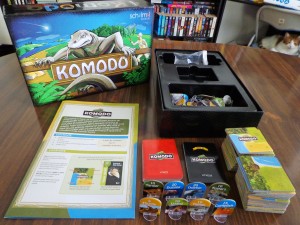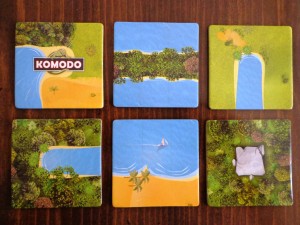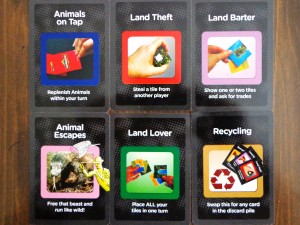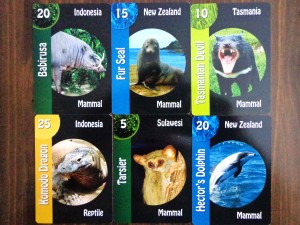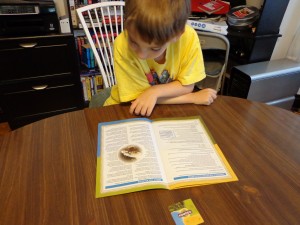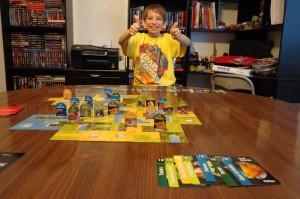My son Vinnie can have a very short attention span at times (as most kids often do), however if there is one thing that I can count on in keeping his attention, it’s television shows about nature. He will sit there for hours, letting his little mind soak in everything it can in regards to animals, reptiles, insects…you name it. He’s often commented that he likes watching Billy the Exterminator because they relocate intruders rather than kill them, not to mention that the show is highly educational. Thus, I was excited when the offer came in to review the game that I’m about to cover.
Komodo is a tile laying game that shares a few similarities with that of Carcassonne, a game that my son enjoys playing. Players will be trying to build habitats via terrain tiles and place the animals within their appropriate habitats. Before we get started with the components, gameplay, and review, I’d like to thank Julia Schiller from SchilMil Games, Ltd. for reaching out to me and for sending me a review copy. She also provided me with a copy of Raid the Pantry, a food themed card game that has a “Rummy” feel to it. Feel free to check out that review as well once you are done here!
Components
Terrain Tiles – There are fifty terrain tiles with combinations of rainforest, grassland, water, and/or desert on them. Included in those fifty tiles is one starter tile, which has the word, “Komodo” on it so that it stands out. Each terrain tile is made up of a 3×3 grid, and each space on that grid counts as one terrain square. More on that in a bit.
Animal Cards – Players will be laying these down in front of them as they place animals on the tiles. This is the primary method in which players score points.
Animal Markers – These work in conjunction with the animal cards and are placed on the tiles to claim habitats.
Wild Cards – Wild cards allow players to perform special actions that mix up the normal flow of play.
Setup
In the basic game, the starter tile is placed in the middle of the table and each player receives two wild cards, five terrain tiles, and three animal cards. Each player must then choose one of those animal cards and reshuffle it back into the deck. The person who begins the game is the one who most recently visited a zoo or wildlife sanctuary.
Gameplay
A player, on their turn, can do the following:
-Play terrain tiles, wild cards, and/or house animals (including those animals of yours that are “on the loose”). -OR-
-Exchange either terrain or animal cards. -OR-
-Re-house another player’s animal that is “on the loose.”
At the end of the player’s turn, a player will draw up to five terrain tiles and two animal cards. If they housed any animals on their turn, they can draw one wild card per animal, up to a hand limit of three. There are exceptions to this rule near the game’s end.
In order for a terrain tile to be placed legally, it must match at least one side (partially is fine) of a tile that it is being placed next to. It is illegal to link two separate animal enclosures together via a tile unless they are of the same species, though you can expand on any current enclosure to make it bigger. The tiles with padlocks on them prevent that terrain’s inhabitants from escaping and being “on the loose.”
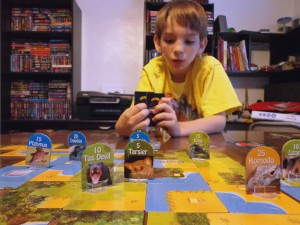
Wild cards can really turn the tide if used at the right time. My son played four animals in a row using the “Animals on Tap” card.
Housing an animal is fairly simple. The animal cards themselves are color coded to match the terrain shown on the tiles. The number listed on each card is the number of blocks required of that terrain. To place a Fiji, you’d need fifteen forest blocks (not tiles) that touch each other. Since each tile has nine blocks, there’s a good chance you’ll be able to place an animal with just a few tiles utilizing the right tile placement. When the land is free to be used (not occupied by an animal of a different species), the player places the animal card in front of them and places the animal token on the habitat.
Animals that are “on the loose” are animals that were initially placed by players but have since escaped as the result of a particular wild card. “On the loose” animal tokens are taken off of the board and placed on the player’s animal card and is fair game to be placed by either that player or by someone else.
Scoring & Endgame
When there are no more tiles to place and each player has less than three terrain tiles, everyone takes one final turn. Players add the point values of the cards they have in front of them, though exclude any animal that is “on the loose.” If players have any animal cards in their hand, they DEDUCT that amount from their score. The person with the most points at that point wins the game.
The above is simply an overview of the game, but it should give you an idea of how the game is played and whether or not the game mechanics interest you.
The Review
Like “Raid the Pantry”, I first noticed the artwork on the cards. They were actual photos of the animals, which drew my son Vinnie (11) in almost immediately. What I particularly liked was the “About the Animals” section of the manual that summarized what each animal was. I must admit that I hadn’t heard of half of these animals until I began playing and looking them up. It is therefore easy to appreciate the educational value associated with the game.
I also particularly liked the fact that there were other variants that you could play. There’s both a strategic mode and a cooperative mode listed in the manual that adds a lot of variety and depth to the basic game. Even without the extra variants, the game has a lot of replayability. The tiles are randomized each game, so the board layout will be different each time you play. Players will be constantly adjusting their strategies as the board continues to evolve and grow.
The wild cards certainly add to the game’s randomness factor. Just when you think you have a particular habitat ready for an animal that you have in your hand, someone might play a wild card and mess up your best laid plans. Wild cards certainly prevent one player from strategically dominating the others.
My son and I played the basic game just to get our feet wet and we had a lot of fun playing it together. He had no trouble understanding the game’s concepts and he even proceeded to pull ahead of me and win. After we were finished, he expressed an interest in trying out the cooperative variant.
As far as tile laying games go, this one ranks up there with the others in my collection. It’s fun, easy to play, and has a great theme to it. It’s a game that I could easily pull out on family fun night as it appeals to a fairly wide audience. If you are a fan of strategic tile laying games, then I recommend that you give this one a good, long look.
Final Verdict: 8/10
You can learn more about the game by visiting SchilMil Games, Ltd., the official Komodo game page, and Board Game Geek here:
You can purchase the game through the SchilMil Games Online Store here:

